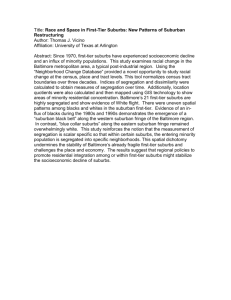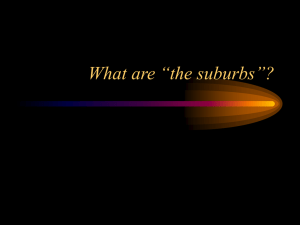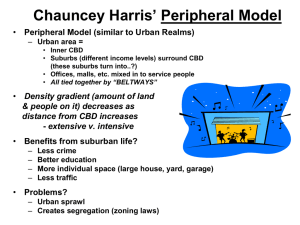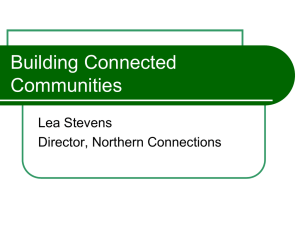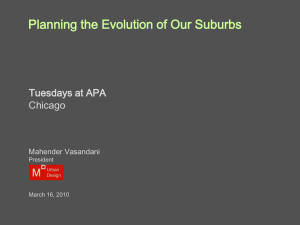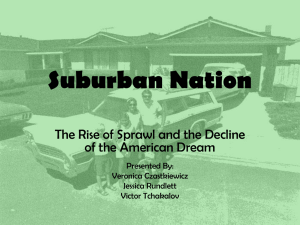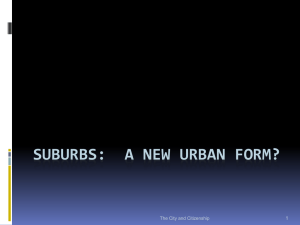Chapter 6
advertisement
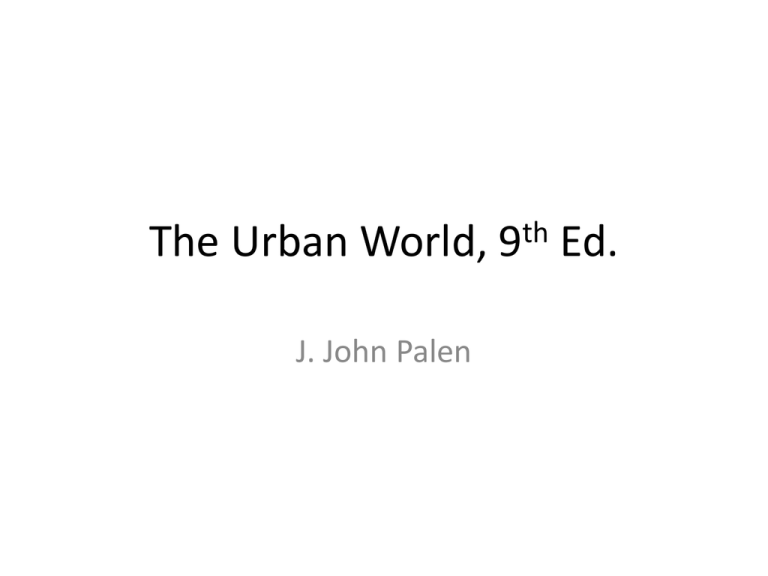
The Urban World, J. John Palen th 9 Ed. Chapter 6: The Suburban Era • • • • • • • • • • • • • • • Introduction Suburban Dominance Emergence of Suburbs Causes of Suburban Growth Contemporary Suburbia Categories of Suburbs Exurbs Rurban Areas Characteristics of Suburbanites Suburban Poverty The Myth of Suburbia Minority Suburbanization Latino Suburbanization Asian Suburbanites Summary Introduction • A role reversal has occurred between cities and suburbs • Suburbs have radically changed, while many of our images of suburbia have remained set in the past • Polls indicate that substantial numbers of those still living in large cities would prefer not to be Suburban Dominance • Economically the suburbs now rule • Politically, suburban voters are in the majority, and their interests now set national and state agendas • The out-movement of offices, manufacturing, and shopping has turned Burgess’s zonal hypothesis inside out and created a multinucleated pattern of outer suburban centers or edge cities Emergence of Suburbs • Suburbs have been called “bourgeois utopias” • Suburbs have been growing faster than central cities for a century • Suburban as defined by the Bureau of the Census simply means territory inside the metropolitan area that lies outside the central city • The 19th Century – The American City of the 19th century was compact, had high density, and could be walked rather quickly – The first to move out were the wealthy – The railroad was important due to the lack of reliable transportation • Electric Streetcar Era: 1890-1920 – The coming of the electric streetcar in 1888 changed the spatial configuration of Boston and other American urban areas from that of a compact city to that of a star-shaped urban area • Annexation – A move from suburbs desiring annexation to be included in big cities to the reverse: suburbs increasingly actively sought “home rule” and opposed annexation – Today the city line is commonly viewed as a social and economic boundary as much as a legal boundary • Automobile Suburbs: 1920-1950 – Ironically, the automobile was initially praised as solving the serious pollution problem cause by horses – To real estate developers, the adoption of automobiles was a boon, for it meant that open land lying between the rail and streetcar axes was now available for residential development • Mass Suburbanization: 1950-1990 – Following the was the exodus of whites from the city included not only the rich and well-to-do but also large numbers of middle-class families and even working-class families – Farmers’ fields were converted to single-family housing developments is well known • Metro Sprawl: 1990-2010 – Sprawl is the term commonly used to refer to the automobile-dependent, low-density housing and commercial development taking place in the outer reaches of metropolitan areas – Sprawl is inherently economically inefficient, wasteful of time and resources, and destructive of the environment – With dispersed growth often comes larger new homes, but also congestion and gridlock – Sprawl has moved to among voters’ top concerns nationally, along with the economy, crime, taxes, and education Causes of Suburban Growth • Postwar Exodus – Six Reasons: • Government policies • Government financing of a system of metropolitan expressways • Land within the legal boundaries of the city had already been developed • Suburban housing costs were initially lower • Demographic changes • Preference of single-family homes with own lots • Non-Reasons – Although the “cause” of suburban growth is commonly contributed to the deterioration of central-city services, poorer-quality city schools, higher urban crime rates, and the high proportion of minorities in city neighborhoods, NONE of these factors had much impact during the first two decades of massive postwar suburbanization – It is important not to automatically project contemporary patterns into the past Contemporary Suburbia • Today suburbs are the major center of employment • An increasingly diversified notion of suburbia • No real decline in the movement to the suburban periphery Categories of Suburbs • Persistence of Characteristics? – In suburbs, the assumption of status change is replaced by the assumption of status consistency • Ethnic and Religious Variation – Within the metropolitan area different ethnic, religious, and racial groups historically often followed specific patterns of suburbanization • High-Income Suburbs – Today, ethnicity and religion tend to have lesser relevance, so long as one has sufficient cash • Gated Communities – As of 2001, over 20,000 gated communities housing over 8 million people have been built, especially in the Southwest • Common-Interest Developments – CIDs are private, self-governing, homeownermembership associations to which everyone in a development must belong as a condition of purchase – Essentially private governments that set the rules for the community • Working-Class Suburbs – The new postwar working-class suburbanites that followed the factories to the suburbs were not fleeing decaying city neighborhoods. More often than not, they were somewhat reluctantly leaving tight ethnic neighborhoods with high levels of social interaction – With the closing of factories, the commercial tax base sharply erodes – Poverty rates are now increasing faster in suburbs than in central cities • Commercial Definitions – Claritas has developed a system that places every zip code in the country into one of 40 different types of communities – These areas have become a virtual Bible for market researchers Exurbs • Exurb refers to the upper-middle-class settlement that is taking place in outlying semirural areas beyond the second ring of densely settled subdivisions • Exurbanites as a rule are affluent, welleducated professionals • Demographic characteristics offer no support for the belief that exurbanites are significantly different from other same-status suburbanites Rurban Areas • Those places beyond the exurbs that are not oriented toward a major city • Some of those living in such “rurban” areas are barely getting by economically in spite of low housing costs and low taxes • These residents are people on the economic margins living in marginal areas Characteristics of Suburbanites • Suburbs are now a microcosm of America • Tend to be homeowners • Young singles, elderly widows, and other such “non-family households” now outnumber married-with-children homes in the nation’s suburbs Suburban Poverty • As of 2010, there were 1.6 million more suburban poor than city poor • Suburban poor are both less served and less seen • Declining property values have reduced local government revenues The Myth of Suburbia • The myth is the belief that there is, in fact, a uniquely suburban way of life • The new myth of suburbia is one that sees the compulsive group conformity of the postwar years replaced by competitive selfadvancement and manic self-fulfillment • The number of scholars studying suburbs remains limited Minority Suburbanization • Suburban Diversity – The reality is that roughly half (47 percent) of the minorities in the nation’s 102 largest metropolitan areas live in the suburbs – Suburbs are increasingly multiethnic and multiracial • Black Flight – White flight to suburbs is largely history – Large central cities continue to have a high proportion of blacks only because of somewhat higher black birthrates • Integration or Resegregation? – Suburbs are becoming more diverse racially – Rather than invasion-succession, with one group supplanting another, stable multiracial suburbs are now more common – While racial equality has not yet arrived, suburban middle-class blacks are becoming more similar to suburban middle-class whites Latino Suburbanization • Latinos are the nation’s largest minority population, and half the Hispanics in the United States today are suburbanites • Half of all Latinos live in either California or Texas • For Hispanics suburban residence is closely associated with higher income levels Asian Suburbanites • Asians, who numbered 14 million in 2010, are the most suburban minority group, with 6 of 10 Asians in America living in suburbs • Over half of all current Asian immigrants bypass the city and go directly to the suburbs • Generally Asians live in suburbs that have a strong Asian presence but are not predominantly Asian

